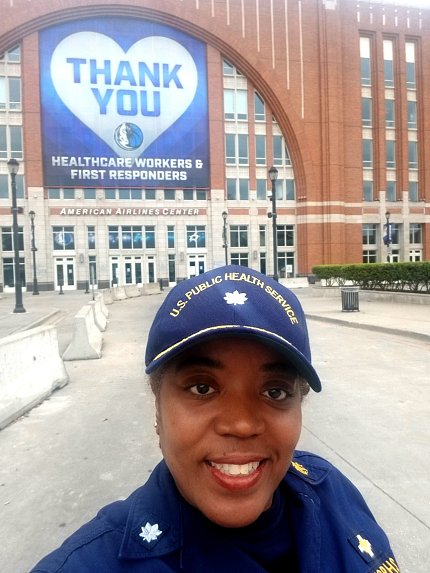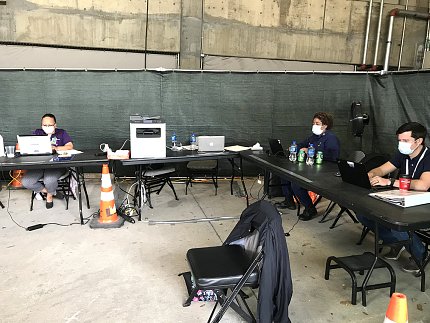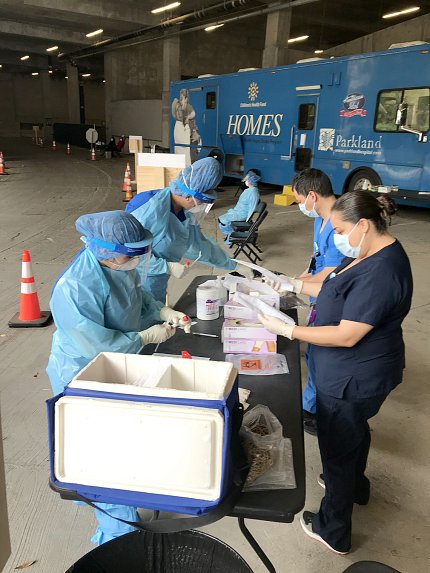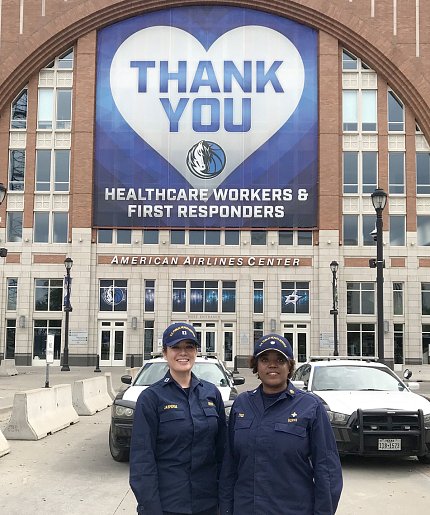‘Epitome of Serving’
NIMHD’s Tyus Returns from Pandemic Deployment

March was her back-up on-call month, so NIMHD’s Dr. Nadra Tyus, a commander in the Public Health Service Commissioned Corps, was hardly surprised when she was asked to deploy. She literally jumped into gear.
The Covid-19 pandemic was already well underway globally. Early in the month, widespread testing for the novel coronavirus had been approved in the U.S. and a national emergency had been declared.
By Mar. 20, Tyus and another PHS officer were working alongside county, state and other federal employees at the American Airlines Center in Dallas.
“I got the request on a Wednesday and I was out by Friday,” she said, explaining the call she received to report for a PHS mission. “They quickly wanted to stand up community-based testing sites—what we call the CBTSs—to bring initial testing capabilities to critical locations across the country.”

One of 2 such facilities to open in Dallas, her CBTS operated 7 days a week, generally from 8 a.m. to 8 p.m. Her assignment lasted 23 days.
“We had a unique partnership there with the City of Dallas and Parkland Hospital, which actually did the swabbing,” Tyus explained. “So the Parkland nurses are the ones interacting with the patients who were there to get tested. It was just a phenomenal local, federal and hospital partnership. My primary role as site lead was to ensure data integrity and the overall integrity of the operations per Radm. Erica Schwartz, the current deputy surgeon general. It was a really good opportunity to see the partnership between the federal government and the local and state officials during this mission.”
The deployment was also a change of pace Tyus relishes every now and again. By day, she’s a health scientist administrator—a program official supporting investigators who do health disparity work. Her portfolio focuses on social and behavioral research.

In contrast, her PHS role puts her in a variety of quickly developing, ever-evolving situations, weather conditions and geographic locations. Tyus also serves as the training lead for her Rapid Deployment Force team. Days on a mission can be exhausting, but also exhilarating.
“I’ve been on a rapid deployment team since 2012,” she said, “so I’ve had a fair amount of deployment experience. And we receive various types of training as public service officers. It really was a seamless kind of transition to be in that role.
“My first [deployment] was on a reservation with the Lakota Sioux Tribe,” she recalled. “I did that within 6 months of getting into the Commissioned Corps. And I’ve done a few hurricanes. I’ve done response and recovery missions with Hurricanes Harvey and Maria. I have at least 5 or 6 deployments under my belt. I love it. I think it’s the epitome of serving your nation with sort of the public health approach. It’s also a chance to do something different from your day job, a definite change of pace. I have to say my current leadership at NIMHD have been so, so supportive.”

Tyus worked previously at a sister HHS agency, the Health Resources and Services Administration, for 9 years. She joined NIH last December.
Putting her most recent 3-week tour in perspective, Tyus said she was very excited about the opportunity to work in the community. In fact, Covid-19 wasn’t even her first infectious disease epidemic. Not long ago, she was called up for an Ebola mission. For Tyus, it’s always the work that matters first and foremost.
“I’m used to the incident command structure, which is under [the Federal Emergency Management Agency], and I deployed to Liberia for Ebola,” she said. “So I’m used to the PPE [personal protective equipment]…Of course, the overall goals are different [for the two missions]. In Liberia, we were focused really on providing care to health care workers in the Ebola treatment unit. That was intense. And [Dallas] was a community-based testing site. So, I’ve had a lot of great experiences that really contributed to this role.”
Tyus’s deployment ended Apr. 11, and she was back to business as usual on Apr. 13.
